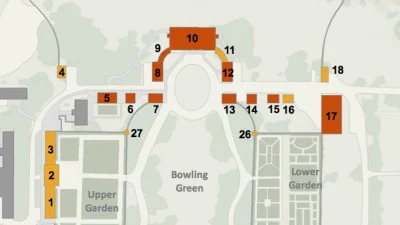Mount Vernon is not just the Mansion George and Martha Washington lived in, it also includes more than a dozen outbuildings.
While the Washingtons oversaw what occurred in these spaces, most of the work was done by enslaved individuals. While visiting Mount Vernon, make sure you don’t miss these buildings.
1. Blacksmith Shop
 The blacksmith worked on projects from mending well-worn pots and making horseshoes, to forging parts for plows. Today you can see blacksmithing demonstrations at Mount Vernon.
The blacksmith worked on projects from mending well-worn pots and making horseshoes, to forging parts for plows. Today you can see blacksmithing demonstrations at Mount Vernon.
Some of Washington’s blacksmith were enslaved individuals while others were hired. The first known blacksmith was Peter, an enslaved man, who worked at Mount Vernon from 1760 to 1770. German immigrant Dominicus Gubner took over the blacksmith shop sometime after 1770. Then from 1774 to 1799, Nat and George, two enslaved men, ran the shop.
2. Spinning House
The spinning house was the hub of activity for cloth production for the over 300 enslaved people on the plantation. In the 18th century, making fabric was an extremely labor-intensive and time-consuming process, done completely by hand, and the fabric was a valuable commodity.
Ten or more enslaved laborers, including Dolsey, Anna, and Judy, were constantly spinning or knitting. Spinning was typically a woman’s job and much of it probably happened alongside other tasks in their work areas or living spaces.
3. Shoemaker's Shop
While the Washington family ordered their shoes, the majority of the shoes enslaved people wore at Mount Vernon were made in this small space. Beginning in the late 1780s, William Lee was responsible for making and repairing all of the shoes.
During the 18th century, shoes and boots were made on straight, symmetrical forms called “lasts.” Without a sole designed specifically for the left or right foot, the shoe gradually molded to the wearer’s foot.
4. Slave Quarters
There are quarters on either side of the Greenhouse where enslaved individuals lived. In each of these rooms, up to 20 people spent time working, eating, and sleeping. Most who lived in this space worked at Mansion House Farm and were house servants, such as Charlotte, or skilled tradesmen like Harry and Kitty.
5. Smokehouse
Make sure you look up in the smokehouse to see dozens of hams hanging from the ceiling. In 1785 alone, approximately 15,885 pounds of hog meat, or about 100 hogs, were processed for consumption at Mount Vernon. To ensure there was enough smoked meat, enslaved individuals kept a fire going year-round inside this structure.
Restoration
The smokehouse is currently under restoration.
Restoration of Mount Vernon’s historic Smokehouse is sponsored by Edwards Virginia Smokehouse.

6. Necessary
Have you ever wondered where the bathrooms were in the Mansion? The simple answer is there weren’t any. In the 18th century, at any one time, there were at least two and probably more necessaries spread out around the Mansion House grounds.
Today you can explore the two restored necessaries. Each has three toilet seats fitted with large, removable wooden drawers under the floor for easy cleaning. People also used chamber pots in their rooms if they did not want to venture out to the necessary.
8. Salt House
This entire structure held salt during the 18th century. Before refrigeration, salting fresh meat, fish, and vegetables was one way to keep them from spoiling. Rinsing fish in a salt solution and then packing them in barrels layered in salt kept fish edible for over a year.
The best salt for preserving food came from Lisbon, Portugal. It was a stable product that didn’t melt easily when it came in contact with wet fish.

Historic Structures
There are four different types of standing historic structures found at Mount Vernon: original, reconstructions, replicas, and period support structures.







